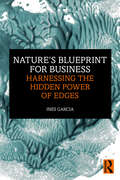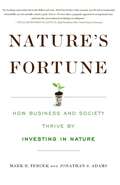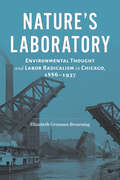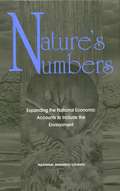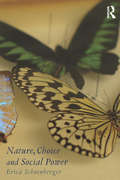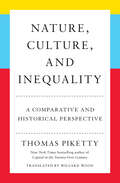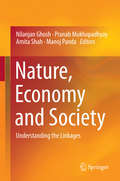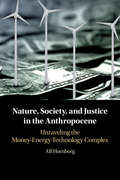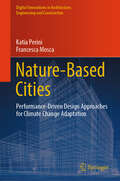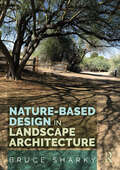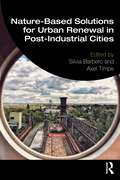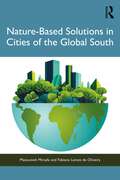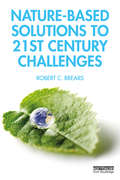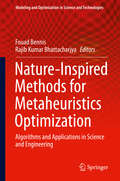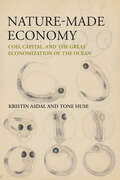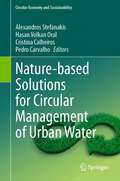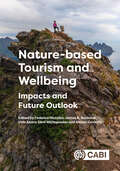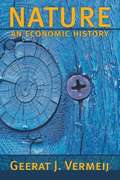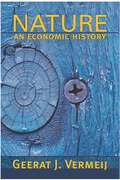- Table View
- List View
Nature's Blueprint for Business: Harnessing the Hidden Power of Edges
by Ines GarciaTapping into proven strategies, mechanisms and patterns that have been fine-tuned over 3.8 billion years, this book bridges the gap between the natural world and the business world and explores how to develop resilient organizations and businesses using lessons from nature.The science of biomimicry is an emerging force in helping us to gaze afresh at the world around us, often inspiring technological inspiration, but we have been slow to look at the organizational and relationship models that are all around us. This book contends that natural abundance flourishes at the edges, where one environmental element contacts another, and that these relationships that have been successful for millennia have endless lessons for us about how we organize ourselves. Each chapter starts with a clear example of a problem that a team or organization might face, goes on to consider a range of natural examples and offer practical suggestions to incorporate nature’s wisdom in the business world, and concludes with success stories of people and organizations already embracing the principles outlined in the book. Employing these principles and aided by suggested activities, readers will develop personalized plans, tailored to their unique situations, to lead their teams’ evolution into thriving organizations.Observing edges, spaces and boundaries shows that is these are where magic happens—and with this book, leaders of all types of teams and organizations will be empowered to make real and immediate changes in their own contexts.
Nature's Fortune: How Business and Society Thrive by Investing in Nature
by Jonathan S. Adams Mark R. TercekWhat is nature worth? The answer to this question-which traditionally has been framed in environmental terms-is revolutionizing the way we do business. In Nature’s Fortune, Mark Tercek, CEO of The Nature Conservancy and former investment banker, and science writer Jonathan Adams argue that nature is not only the foundation of human well-being, but also the smartest commercial investment any business or government can make. The forests, floodplains, and oyster reefs often seen simply as raw materials or as obstacles to be cleared in the name of progress are, instead, as important to our future prosperity as technology or law or business innovation. Who invests in nature, and why? What rates of return can it produce? When is protecting nature a good investment? With stories from the South Pacific to the California coast, from the Andes to the Gulf of Mexico and even to New York City, Nature’s Fortune shows how viewing nature as green infrastructure allows for breakthroughs not only in conservation-protecting water supplies; enhancing the health of fisheries; making cities more sustainable, livable and safe; and dealing with unavoidable climate change-but in economic progress, as well. Organizations obviously depend on the environment for key resources-water, trees, and land. But they can also reap substantial commercial benefits in the form of risk mitigation, cost reduction, new investment opportunities, and the protection of assets. Once leaders learn how to account for nature in financial terms, they can incorporate that value into the organization’s decisions and activities, just as habitually as they consider cost, revenue, and ROI. Such a rethinking of "natural capital”-nature as a quantifiable asset-can not only increase profitability, but provide crucial protection against the kinds of climate change-driven phenomena-like devastating drought and hundred-year floods-that are no longer the stuff of speculation. A must-read for business leaders, CEOs, investors, and environmentalists alike, Nature’s Fortune offers an essential guide to the world’s economic-and environmental-well-being.
Nature's Laboratory: Environmental Thought and Labor Radicalism in Chicago, 1886–1937
by Elizabeth Grennan BrowningThe untold history of how Chicago served as an important site of innovation in environmental thought as America transitioned to modern, industrial capitalism.In Nature's Laboratory, Elizabeth Grennan Browning argues that Chicago—a city characterized by rapid growth, severe labor unrest, and its position as a gateway to the West—offers the clearest lens for analyzing the history of the intellectual divide between countryside and city in the United States at the end of the nineteenth century. By examining both the material and intellectual underpinnings of Gilded Age and Progressive Era environmental theories, Browning shows how Chicago served as an urban laboratory where public intellectuals and industrial workers experimented with various strains of environmental thinking to resolve conflicts between capital and labor, between citizens and their governments, and between immigrants and long-term residents. Chicago, she argues, became the taproot of two intellectual strands of American environmentalism, both emerging in the late nineteenth century: first, the conservation movement and the discipline of ecology; and second, the sociological and anthropological study of human societies as "natural" communities where human behavior was shaped in part by environmental conditions. Integrating environmental, labor, and intellectual history, Nature's Laboratory turns to the workplace to explore the surprising ways in which the natural environment and ideas about nature made their way into factories and offices—places that appeared the most removed from the natural world within the modernizing city. As industrialization, urbanization, and immigration transformed Chicago into a microcosm of the nation's transition to modern, industrial capitalism, environmental thought became a protean tool that everyone from anarchists and industrial workers to social scientists and business managers looked to in order to stake their claims within the democratic capitalist order. Across political and class divides, Chicagoans puzzled over what relationship the city should have with nature in order to advance as a modern nation. Browning shows how historical understandings of the complex interconnections between human nature and the natural world both reinforced and empowered resistance against the stratification of social and political power in the city.
Nature's Numbers: Expanding the National Economic Accounts to Include the Environment
by National Research CouncilIn order to really see the forest, what's the best way to count the trees? Understanding how the economy interacts with the environment has important implications for policy, regulatory, and business decisions. How should our national economic accounts recognize the increasing interest in and importance of the environment?Nature's Numbers responds to concerns about how the United States should make these measurements. The book recommends how to incorporate environmental and other non-market measures into the nation's income and product accounts.The panel explores alternative approaches to environmental accounting, including those used in other countries, and addresses thorny issues such as how to measure the stocks of natural resources and how to value non-market activities and assets. Specific applications to subsoil minerals, forests, and clean air show how the general principles can be applied.The analysis and insights provided in this book will be of interest to economists, policymakers, environmental advocates, economics faculty, businesses based on natural resources, and managers concerned with the role of the environment in our economic affairs.
Nature, Choice and Social Power
by Erica SchoenbergerWe are at an environmental impasse. Many blame our personal choices about the things we consume and the way we live. This is only part of the problem. Different forms of social power - political, economic and ideological - structure the choices we have available. This book analyses how we make social and environmental history and why we end up where we do. Using case studies from different environmental domains – earth and water, air and fire – Nature, Choice and Social Power examines the form that social power takes and how it can harm the environment and hinder our efforts to act in our own best interests. The case studies challenge conventional wisdoms about why gold is valuable, why the internal combustion engine triumphed, and when and why suburbs sprawled. The book shows how the power of individuals, the power of classes, the power of the market and the power of the state at different times and in different ways were critical to setting us on a path to environmental degradation. It also challenges conventional wisdoms about what we need to do now. Rather than reducing consumption and shrinking from outcomes we don’t want, it proposes growing towards outcomes we do want. We invested massive resources in creating our problems; it will take equally large investments to fix them. Written in a clear and engaging style, the book is underpinned with a political economy framework and addresses how we should understand our responsibility to the environment and to each other as individuals within a large and impersonal system.
Nature, Culture, and Inequality: A Comparative and Historical Perspective
by Thomas Piketty&“The most important economics book of the year―and maybe of the decade.&” —Paul Krugman, New York Times, on Capital in the Twenty-First Century A bestselling economist&’s history of inequality and guide to a more just, sustainable world, distilled into an engaging and accessible pocket-sized text.In this unique work, Thomas Piketty presents a synthesis of his historical and comparative research on inequality. He challenges the idea that there could be natural inequalities and shows that the march toward equality has always depended on political and social struggles, addressing diverse topics such as: education, inheritance, the climate crisis, the taxation of wealth, and gender disparities. Adapted from Piketty&’s 2022 lecture at the Musée du Quai Branly – Jacques Chirac, Nature, Culture, and Inequality makes his important argument available to a wider audience for the first time. With a clear, conversational tone, he provides a strong foundation of data and concrete examples of how we can continue to level the playing field.
Nature, Economy and Society
by Nilanjan Ghosh Pranab Mukhopadhyay Amita Shah Manoj PandaThis book presents an enquiry into the interface between nature, economy and society, which is still in its early stages, notwithstanding the commendable progress and advances made in the field of environmental and natural resource economics within the ever-expanding boundaries of economics as a discipline. It further delineates the evolution of an inter-disciplinary framework for analyzing the status, the future goals, mechanisms and policy instruments that can help move towards a more ecologically sustainable, economically beneficial and socially just future. A pre-requisite for preparing a comprehensive and coherent framework involves unfolding the multiple layers of interconnectedness between the three systems nature, economy and society, each of which has its own internal consistencies as well as externalities. Against this backdrop, the book presents scholarly contributions that focus on four broadly defined building blocks, namely: i) accounting for ecosystems services for life and human well-being; ii) impacts of economic growth on ecosystems; iii) social norms, equity, and governance; and iv) alternative approaches to green and socio-economic systems. The analyses, presented by some of the most eminent national and international scholars, address the major environmental challenges that nations around the world face today and consider which specific policy directions at the international and national level are needed. In particular, the choices India and South Asia now face, as development and environment both need to be addressed adequately, touch on many of these challenges.
Nature, Society, and Justice in the Anthropocene: Unraveling the Money-Energy-Technology Complex (New Directions in Sustainability and Society)
by Alf HornborgAre money and technology the core illusions of our time? In this book, Alf Hornborg offers a fresh assessment of the inequalities and environmental degradation of the world. He shows how both mainstream and radical economists are limited by a particular worldview and, as a result, do not grasp that conventional money is at the root of many of the problems that are threatening societies, not to mention planet Earth itself. Hornborg demonstrates how market prices obscure asymmetric exchanges of resources - human labor, land, energy, materials - under a veil of fictive reciprocity. Such unequal exchange, he claims, underpins the phenomenon of technological development, which is, fundamentally, a redistribution of time and space - human labor and land - in world society. Hornborg deftly illustrates how money and technology have shaped our thinking and our social and ecological relations, with disturbing consequences. He also offers solutions for their redesign in ways that will promote justice and sustainability.
Nature-Based Cities: Performance-Driven Design Approaches for Climate Change Adaptation (Digital Innovations in Architecture, Engineering and Construction)
by Katia Perini Francesca MoscaThis book introduces a groundbreaking approach to urban design, addressing site-specific challenges arising from the impacts of climate change. It provides an overview of the most relevant climate change impacts and related adaptation strategies, aligning with sustainable development goals. Nature-based solutions (NBS) are some of the most significant adaptation strategies, yet the book addresses the lack of quantitative approaches for their design. A design approach and related methodology that can be used by designers with different levels of complexity is presented, discussing its applicability and limitations according to selected key performance indicators and related thresholds. Such methodology and the related tools are applied to case studies with a focus on the performance of NBS in improving thermal comfort (microclimate regulation) and reducing flooding risks (stormwater retention). A final workflow for a coupled performance-driven design approach is presented for readers, offering a pathway to define design strategies based on site-specific key performance indicators. The target audience includes practitioners, urban designers and planners, researchers, and anyone interested in urban environment design, nature-based solutions, and computational approaches to sustainable design.
Nature-Based Design in Landscape Architecture
by Bruce SharkyNature-Based Design in Landscape Architecture showcases a range of built works designed by landscape architects from many countries of the world representing diverse environmental regions and uses. These projects demonstrate the transformative potential of a nature-based approach to landscape architecture.The nature-based design approach supports and encourages natural regeneration with a view to promoting sustainable environments, preserving natural resources, and mitigating the impacts of climate change and development. The projects selected for this book demonstrate the potential of nature-based landscape design to support healthy, natural and managed ecosystems, sequester carbon, and support the recovery of biodiversity. In addition to examples of design-led environmental interventions, Nature-Based Design in Landscape Architecture, the book, also demonstrates the potential for nature-based design to improve people’s relationship with their surroundings by encouraging them to be active participants in their communities. As such, each project featured in the book promotes a discussion around future scenarios in which landscape architects can and will be engaged, from minimizing environmental impact through sustainable design to fostering social justice through community engagement.This book will be a welcome supplement for undergraduate landscape architecture, survey or design studio courses, and may also be used at the master’s degree level either as part of a landscape architecture survey seminar or early design studio.
Nature-Based Solutions for Urban Renewal in Post-Industrial Cities
by Silvia Barbero Axel TimpeThis book, based on the experiences and insights gained during the Horizon 2020 project proGIreg, offers a detailed overview of targeted nature-based solutions and their impacts on various key sustainability areas, guiding readers through the spatial analysis, co-design, and implementation processes of cities in Europe and Asia. Chapters shed light on the challenges and opportunities encountered in each location, including Germany, Italy, Croatia, Bosnia and Herzegovina, Greece, Portugal, Romania and China. It also shares essential lessons learned and a wide range of indicators crucial for assessing the benefits of nature-based solutions on social innovation, circular economy, biodiversity, and health. Finally, the focus of this book shifts to the future of nature-based solutions as catalysts for new and green community economies as well as policies aimed at addressing climate change and urban renewal. The lessons and insights from the projects highlighted in this book will be valuable for urban planners and policymakers worldwide, as well as for a broader audience interested in nature-based solutions and urban regeneration.The Open Access version of this book, available at www.taylorfrancis.com, has been made available under a Creative Commons CC-BY 4.0 license.
Nature-Based Solutions in Achieving Sustainable Development Goals: Harmonizing Nature and Progress
by Pardeep Singh Prateek Srivastava Alexander SorokinThis book provides a comprehensive guide to leveraging nature-based economic initiatives for sustainable rural development. The book covers a wide range of topics, including promoting agroecology and sustainable fisheries for achieving food security, ecosystem-based approaches for water resource management, nature-driven renewable energy systems, and nature-based urban resilience. The book also explores the impact of nature-based interventions on ecosystems and human health, augmenting carbon sink capacities, ecological conservation and sustainable management of marine environments, ecosystem restoration and biodiversity conservation for land stewardship, and promoting multi-stakeholder collaboration for nature-based sustainable development. The book presents a didactic approach, with illustrations, tables, and a new form of presentation that makes it easy to understand and apply the concepts. The methods, results, and topics covered in the book will be of particular interest to readers interested in sustainable development, environmental conservation, and rural development. The book provides readers with a deep understanding of nature-based solutions and their potential to address societal challenges through the protection, sustainable management, and restoration of both natural and modified ecosystems. The main benefit that readers will derive from the book is a comprehensive understanding of nature-based solutions and their potential to address major challenges like climate change, disaster risk reduction, food and water security, biodiversity loss, and human health. The book provides readers with practical solutions to leverage nature-based economic initiatives for sustainable rural development. The book is an essential resource for policymakers, researchers, practitioners, and students interested in sustainable development, environmental conservation, and rural development.
Nature-Based Solutions in Cities of the Global South
by Masoumeh Mirsafa Fabiano Lemes de OliveiraThis book explores the practice of Nature-Based Solutions (NBS) in the cities of the Global South. NBS are recognized as a key strategy for achieving sustainable development, and they are being implemented in a variety of sectors such as urban planning, agriculture, forestry, and water management. They offer a wide range of benefits, but there is a gap between research and practice across cities from the Global South. This book promotes implemented urban NBS projects in the Global South to help identify region-specific challenges and opportunities, and to develop more effective and equitable solutions. The presented case studies support resilient planning in the Global South and significantly inform urban debates in the Global North. This book offers pragmatic policy and planning recommendations, providing decision-makers with clear guidance on implementing NBS in urban settings and transforming knowledge into actionable strategies for sustainable and resilient urban development.
Nature-Based Solutions to 21st Century Challenges
by Robert C. BrearsThis book provides a systematic review of nature-based solutions and their potential to address current environmental challenges. In the 21st century, society is faced by rapid urbanisation and population growth, degradation and loss of natural capital and associated ecosystem services, an increase in natural disaster risks, and climate change. With growing recognition of the need to work with ecosystems to resolve these issues there is now a move towards nature-based solutions, which involve utilising nature’s ecosystem to solve societal challenges while providing multiple co-benefits. This book systematically reviews nature-based solutions from a public policy angle, assessing policy developments which encourage the implementation of nature-based solutions to address societal challenges while simultaneously providing human well-being and biodiversity benefits. This includes enhancing sustainable urbanisation, restoring degraded ecosystems, mitigating and adapting to climate change, and reducing risks from natural disasters. While nature-based solutions can be applied strategically and equitably to help societies address a variety of climatic and non-climatic challenges, there is still a lack of understanding on how best to implement them. The book concludes by providing a best practice guide for those aiming to turn societal challenges into opportunities. This book will be of great interest to policymakers, practitioners and researchers involved in nature-based solutions, sustainable urban planning, environmental management, and sustainable development generally.
Nature-Based Tourism in Asia’s Mountainous Protected Areas: A Trans-regional Review of Peaks and Parks (Geographies of Tourism and Global Change)
by Huong T. Bui Michal Apollo Thomas E. JonesThis book provides holistic insights into management of protected areas across East Asia and identifies current trends in mountain tourism within the broader field of human geography and nature conservation. The book describes the diversification in visitors and expanding protected areas territories in different Asian countries during recent years. It also compares protected areas networks in the context of the changing demographic profiles of visitors and provides an interdisciplinary transnational appraisal of mountain-based tourism in Asia based on national and international statistics. The research combines specific case studies at the individual country and destination level with trans-regional trends, thereby offering analysis from both the perspective of supply (parks, protected areas, and stakeholders) and demand (mountain tourist market trends and segments). The book is a useful resource for students and academics in tourism and protected areas studies as well as social scientists and policy-makers interested in Asian countries.
Nature-Based Tourism in Peripheral Areas
by Stephen Boyd C. Michael HallThis book provides one of the first detailed examinations of the problems of nature-based tourism development in peripheral areas. A diverse range of environments is used to illustrate the challenges and difficulties of managing nature-based tourism resources. A central theme throughout the book is the degree of opportunity that nature-based tourism provides as the basis for peripheral region development.
Nature-Inspired Methods for Metaheuristics Optimization: Algorithms and Applications in Science and Engineering (Modeling and Optimization in Science and Technologies #16)
by Fouad Bennis Rajib Kumar BhattacharjyaThis book gathers together a set of chapters covering recent development in optimization methods that are inspired by nature. The first group of chapters describes in detail different meta-heuristic algorithms, and shows their applicability using some test or real-world problems. The second part of the book is especially focused on advanced applications and case studies. They span different engineering fields, including mechanical, electrical and civil engineering, and earth/environmental science, and covers topics such as robotics, water management, process optimization, among others. The book covers both basic concepts and advanced issues, offering a timely introduction to nature-inspired optimization method for newcomers and students, and a source of inspiration as well as important practical insights to engineers and researchers.
Nature-Made Economy: Cod, Capital, and the Great Economization of the Ocean
by Kristin Asdal Tone HuseAn exploration of the economization of the ocean through the small modifications that enable great transformations of nature.The ocean is the site of an ongoing transformation that is aimed at creating new economic opportunities and prosperity. In Nature-Made Economy, Kristin Asdal and Tone Huse explore how the ocean has been harnessed to become a space of capital investment and innovation, and how living nature is wrested into the economy even as nature, in turn, resists, adapts to, or changes the economy. The authors&’ innovative methodological and conceptual approaches examine the economy by focusing on surprising and numerous &“little tools&”—such as maps and policy documents, quality patrols, and dietary requirements for the enhancement of species&’ biological propensities—that value, direct, reorder, accomplish, and sometimes fail to serve our ends, but also add up to great change.Throughout Nature-Made Economy, Asdal and Huse follow one species, the Atlantic cod, and explore how it is subjected to different versions of economization. Taking this species as a point of departure, they then provide novel analyses of the innovation economy, the architecture of markets, the settling of prices, and more, revealing how the ocean is rendered a space of intense economic exploitation. Through their analysis, the authors develop a distinct theoretical approach and conceptual vocabulary for studying nature–economy relations.Nature-Made Economy is a significant contribution to the broad field of STS and social studies of markets, as well as to studies of the Anthropocene, the environment, and human–animal relations.
Nature-based Solutions for Circular Management of Urban Water (Circular Economy and Sustainability)
by Alexandros Stefanakis Hasan Volkan Oral Cristina Calheiros Pedro CarvalhoDespite the strong economic growth of the last decades, our modern global society is facing the existential threat of climate change. It is now realized that the linear economic model is not sustainable in the long run and cannot sustain the life standards. The new circular economy approach that is already under discussion suggests the adjustment of our priorities and the re-orientation of the future infrastructure investments. In this context, we are looking for new, innovative and sustainable solutions to increase the resiliency of our societies, to protect and restore the ecosystems, and to maintain the necessary economic growth without further undermining the planet’s boundaries. The well-being of coming generations will depend on our ability to adapt our economies to this challenge. In particular, transforming today’s cities into sustainable cities is one of the main adaptations that will be necessary. A holistic approach looking at cities from a system’s perspective is neededto achieve this goal. Nature-based solutions (NbS) serve exactly this ambitious and multi-factorial purpose due to their inherent ability not only to tackle climate change but also to provide a series of ecosystem services and social benefits. In the urban context, NbS can deal with main challenges such as urban heat islands, flooding, treatment of wastewater and runoff and food provision. At the same time, NbS can provide a series of ecosystem services beneficial for the environment and the society including clean water production, nutrient recovery, heavy metals retention and a broad range of plant-based materials. In the new circular economy paradigm, NbS can contribute to strategies for climate change adaptation and create a holistic resource management system for the urban biosphere. Thus, this book aims at providing a single reference that discusses the role and effectiveness of NbS in the urban environment and how these systems can contribute to the circular management of water, nutrients and resources towards resilient, sustainable and healthy cities. The scope of the book extends to various fields and disciplines such as the built environment, urban water and wastewater, resource recovery, urban farming, smart sensing, research and development, technology and innovation, society and governance. Research studies, pilot projects, and case studies are part of the book.
Nature-based Tourism and Wellbeing: Impacts and Future Outlook
by Federico Niccolini, James R. Barborak, Iride Azara, Eleni Michopoulou and Alessio CavicchiAll around the world, as growing numbers of tourists and recreational visitors flock to protected and other natural areas stimulated by a renewed search for physical, mental, and even spiritual health and wellbeing, different practices and behaviours emerge. This book brings together experiences and perspectives from many countries around the world. On the demand side, the experiences are united by the desire of tourists to find a real and regenerating connection in nature. On the supply side, designing and managing tourist systems that preserve natural capital in good condition requires great professionalism to dynamically maintain a fragile and delicate balance between tourists, local communities, and nature. By understanding the attitudes and emerging norms of behaviour within the context of nature-based tourism, we can begin to sketch a roadmap to enable more holistic, enjoyable, healthy and responsible visitor experiences; facilitate ecosystem conservation; contribute to the mental and physical wellbeing of tourists and outdoor recreationists; and build sustainable economies and resilient destinations and livelihoods. This book is of great relevance for academic researchers, advanced tourism and conservation students, and practitioners working in nature-based tourism and conservation, especially those with a focus on natural destinations, as well as those interested in consumer behaviour, business and management, recreation, and sustainable tourism development.
Nature: An Economic History
by Geerat J. VermeijFrom humans to hermit crabs to deep water plankton, all living things compete for locally limiting resources. This universal truth unites three bodies of thought--economics, evolution, and history--that have developed largely in mutual isolation. Here, Geerat Vermeij undertakes a groundbreaking and provocative exploration of the facts and theories of biology, economics, and geology to show how processes common to all economic systems--competition, cooperation, adaptation, and feedback--govern evolution as surely as they do the human economy, and how historical patterns in both human and nonhuman evolution follow from this principle. Using a wealth of examples of evolutionary innovations, Vermeij argues that evolution and economics are one. Powerful consumers and producers exercise disproportionate controls on the characteristics, activities, and distribution of all life forms. Competition-driven demand by consumers, when coupled with supply-side conditions permitting economic growth, leads to adaptation and escalation among organisms. Although disruptions in production halt or reverse these processes temporarily, they amplify escalation in the long run to produce trends in all economic systems toward greater power, higher production rates, and a wider reach for economic systems and their strongest members. Despite our unprecedented power to shape our surroundings, we humans are subject to all the economic principles and historical trends that emerged at life's origin more than 3 billion years ago. Engagingly written, brilliantly argued, and sweeping in scope, Nature: An Economic History shows that the human institutions most likely to preserve opportunity and adaptability are, after all, built like successful living things.
Nature: An Economic History
by Geerat VermeijFrom humans to hermit crabs to deep water plankton, all living things compete for locally limiting resources. This universal truth unites three bodies of thought--economics, evolution, and history--that have developed largely in mutual isolation. Here, Geerat Vermeij undertakes a groundbreaking and provocative exploration of the facts and theories of biology, economics, and geology to show how processes common to all economic systems--competition, cooperation, adaptation, and feedback--govern evolution as surely as they do the human economy, and how historical patterns in both human and nonhuman evolution follow from this principle. Using a wealth of examples of evolutionary innovations, Vermeij argues that evolution and economics are one. Powerful consumers and producers exercise disproportionate controls on the characteristics, activities, and distribution of all life forms. Competition-driven demand by consumers, when coupled with supply-side conditions permitting economic growth, leads to adaptation and escalation among organisms. Although disruptions in production halt or reverse these processes temporarily, they amplify escalation in the long run to produce trends in all economic systems toward greater power, higher production rates, and a wider reach for economic systems and their strongest members. Despite our unprecedented power to shape our surroundings, we humans are subject to all the economic principles and historical trends that emerged at life's origin more than 3 billion years ago. Engagingly written, brilliantly argued, and sweeping in scope, Nature: An Economic History shows that the human institutions most likely to preserve opportunity and adaptability are, after all, built like successful living things.
NatureSweet
by Natalie Kindred Forest Reinhardt Jose B. AlvarezThis case describes the business model and workplace philosophy of NatureSweet, a privately owned, vertically integrated greenhouse grower and marketer of fresh tomatoes with sales across the U.S. and $329 million in 2016 revenues. CEO Bryant Ambelang treated NatureSweet more like a consumer-packaged goods manufacturer than an agricultural producer, with a focus on consistency, branding, margin and price stability, and a frontline-worker-centric production model inspired by the Toyota Production System. Workers-who, because of NatureSweet's year-round greenhouse production model, were employed full time-were empowered with training and productivity incentives, allowing them to earn well above the minimum wage and advance their careers within the company. Indeed, improving the lives of workers was the explicit purpose of NatureSweet's operations. Through its financial incentives, personal and professional development initiatives, and worker-appreciation programs, NatureSweet had cultivated a truly unique, uplifting workplace culture in its Mexico operations. Ambelang aspired to replicate the model in the U.S. as a way of demonstrating the potential to "transform the lives of agricultural workers in North America." But in late 2017, the Arizona-based production operations that NatureSweet had acquired in 2014 were still struggling to attain the successes achieved in Mexico. This case describes NatureSweet's history, achievements in Mexico, and challenges in Arizona, inviting students to evaluate the keys to NatureSweet's success in Mexico and analyze their potential for replication in the U.S. Will Ambelang succeed in Arizona, and in doing so demonstrate that it is possible to transform the lives of agricultural workers in North America?
Natureview Farm
by Karen Martinsen FlemingExplores channel management issues in the U.S. food industry. Natureview Farm, a Vermont-based producer of organic yogurt with $13 million in revenues, is the leading national yogurt brand (24% market share) sold into natural foods stores. It has achieved this through its special yogurt manufacturing process and through cultivating personal relationships with dairy buyers in the natural foods channel. Set in 2000, when the company faces financial pressure to grow revenues to $20 million by the end of 2001 due to a planned exit by its venture capital investors. The immediate decision point that the protagonist, Natureview's vice president of marketing, faces is whether to achieve this revenue growth by expanding into the supermarket channel.
Naturkatastrophen und individuelles Verhalten in Entwicklungsländern: Risiko, Vertrauen und die Nachfrage nach Mikroversicherungen
by Oliver FialaDiese Studie untersucht den komplexen Zusammenhang zwischen Naturkatastrophen, individuellem Verhalten - in Form von individueller Risikobereitschaft und Vertrauensniveau - und der Nachfrage nach Mikroversicherungen. Entwicklungsländer sind besonders anfällig für die Auswirkungen von Naturkatastrophen und Klimawandel, da diese ihre Entwicklungsprozesse beeinträchtigen und die Bemühungen zur Armutsbekämpfung zurückwerfen. Unter Verwendung eines einzigartigen Datensatzes für das ländliche Kambodscha, der auf einer Umfrage, experimentellen Spielen und einem diskreten Auswahlexperiment basiert, unterstreicht die Studie die Bedeutung von Wahrnehmungen, Erwartungen und psychologischen Faktoren in Entscheidungsprozessen mit erheblichen Folgen für langfristige wirtschaftliche Perspektiven und die Armutsbekämpfung.
